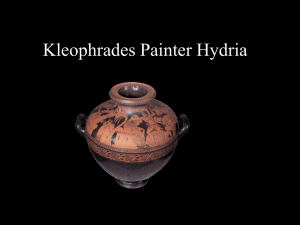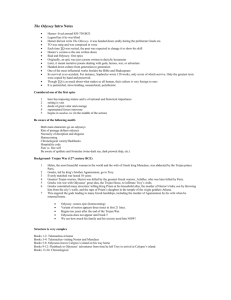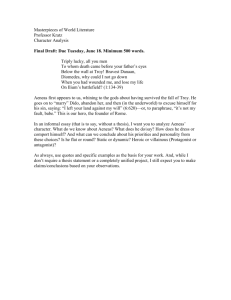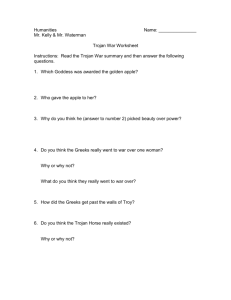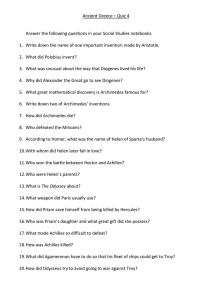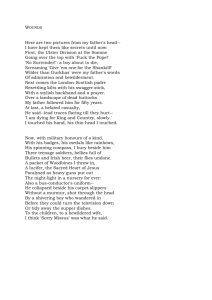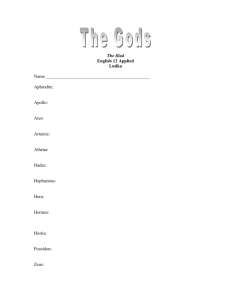Kleophrades_Painter-HydriaJSE
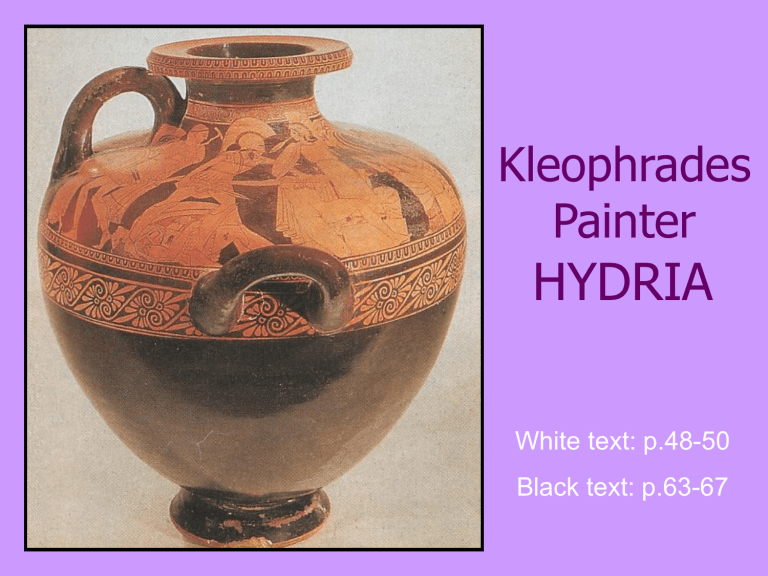
Kleophrades
Painter
HYDRIA
White text: p.48-50
Black text: p.63-67
Kleophrades Painter
Kleophrades painter was one of the best of the Red-Figure decorators. He was the son of Amasis, and a student of
Euthymides.
He was sometimes painted in Black-Figure, but was a follower of the Pioneer group of
Red-Figure decorators. He shared their interests in innovations in vase decoration.
•
Shape: Hydria
•
Purpose: carrying water
•
Painter:
Kleophrades painter
•
Potter:
Kleophrades
•
Technique:
Red-figure
•
Date: 500-480
B.C.
Dimensions
Height: 45 cm
Inscriptions
There are no signatures or inscriptions on this vase.
Mood
The sacking of Troy presents four moods.
•
Cruelty : sacrilege, murder,rape and despair
•
Courage : Trojan women fighting fully armed soldiers
•
Liberation :Aithra being rescued by her grandsons
•
Hope : Aeneas’ escape with his father and to found a new Troy
This is a not a tale of triumph for the Greeks rather one of despair for the Trojans.
This vase may be seen as a picture of the horrors of war
– a savage act of victory and vengeance of which the
Greeks were ashamed
Decoration Overview
Side A
•
New advances in spatial representation as the decoration is all painted around the neck and shoulder of the vase
•
Increase in overlapping of figures
•
The painter has three quarter technique to give an unusual perspective of the inside of the warrior’s shield while his left thigh and foot have been foreshortened in their frontal pose.
•
To the far right of this pair is a triangle shaped grouping delibrately removed from the heat of the battle so that appear to join in both halves of the continuous narrative together.
•
The two fully armed and bearded warriors are beautifully contrasted to the defenceless old woman cowering on the ground
Side B
•
The painter has once again employed foreshortening in his depiction of
Cassandra’s leg
•
Aeneas is painted from a back view and waling beside him is his young son,
Ascanius
Side A
CRUELTY
The
Sack of
Troy and the
Death of
Priam
The top of the vase is one frieze which runs continuously around the top of the vase, between the neck and the shoulder. It is divided into separate triangular scenes which tell separate stories.
Virgil’s “Aeneid”
The death of Priam
Neoptolemos, referred to by Virgil as Pyrrhus, kills Priam's son Polites in front of him on the altar of
Zeus the Protector, where Priam and his family have taken refuge.
Priam, though death now ringed him round, could not be passive,
Could not refrain from uttering his indignation. He cried:
"Hear me, you criminal! If there is any justice in heaven,
Any eye for such things, may the gods pay you the due reward
And unstintingly show their gratitude for this most monstrous crime
You have committed - making me witness my son's death,
Fouling a father's eyes like this with the sight of murder!
You are poles apart from Achilles - your father, you lyingly claim.
He treated me differently far, though I was his foe; he respected
A suppliant's rights, gave up the bloodless remains of Hector
For burial, and gave me safe conduct back to my city."
So saying, the old man flung his weapon, but harmlessly -
No strength behind it; a clang when the shield of Pyrrhus parried it,
And then the spear was dangling impotently from its centre.
Pyrrhus replied: "All right, you shall go and carry a message
To my father Achilles. Remember to tell him what a milksop
His son has become, and what shocking deed he has committed.
Now die!"
Even as he spoke, he dragged the old man, trembling,
And sliding in the pool of his son's blood, right to the altar;
Twined Priam's hair in his left hand, raised with his right the flashing
Sword, and sank it up to the hilt between his ribs.
The death of
King
Priam
The focus of this section is the bloodstained figure of
King Priam who sits on the altar cradling the limp, goresmeared body of his grandson, Astyanax the son of Hector
Priam is depicted as an old man with a bald head and a stubby beard. He covers his head with his heads in a futile gesture to ward off the fatal blow about to be dealt to him by
Neoptolemus, the son of Achilles
NEOPTOLEMUS
Unusually he has been presented from the rear, with his head and left leg in profile.
He is dressed in full battle armour. His huge sword, the so called Machaira, appears to disappear under the lip of the hydria.
He has been painted in detail, especially on his armour
A dead trojan lies at Neoptolemus’ feet. He grasps the inside of his shield which is presented in a perspective view, while his lower leg appears foreshortened as it disappears behind his thigh. The details of the dead bodies reinforce the sense of the horror of war.
COURAGE
The heroism of a
Trojan woman
A fully armed greek warrior crouches under his shield as he is attacked by an angry Trojan woman armed with a large pestle or a chair leg. This suggests she is desperate.
The painter has used the three-quarter technique to give a perspective of the inside of the warrior’s shield, while his left thigh has been foreshortened.
The Rescue of Aithra
LIBERATION
Further round the vase is a triangle shaped grouping so that they appear to join both havles of the continuous narrative together.
In a touching scene, Akamas and Demophon, sons of
Theseus, help their grandmother Aithra who was taken to Troy with Helen to act as her maidservant. The two bearded warriors are beautifully contrasted with the defenceless old woman cowering on the ground.
The final figure in the group is a young girl mourning on the far right.
See page 65 in Black text for a view of the whole frieze.
Side B
Crouching Trojan women
DESPAIR
A Trojan woman crouches beneath a battered palm tree
(bent to emphasise the destruction of Troy), tearing her hair out in a gesture of mourning.
A second trojan woman sits next to her covering her head in terror, behind a statue of Athena (called the Palladium – the most sacred object in Troy)
CRUELTY
The Rape of
Cassandra
The focus of this section is a scene of extreme violence which involves Cassandra, the daughter of Priam. She is being ripped away from the statue. Her attacker the greek hero, Ajax, grabs her by the hair while she implores him with her outstreched palm
The Myth
Cassandra was the daughter of Priam and Hecuba. She was said to be as lovely as Aphrodite. Apollo loved her and promised to teach her the art of prophecy. He hoped she would fall in love with him, but she rejected his advances.
Apollo was so upset he spat into her mouth so that she would speak the truth but was fated never to be listened to.
She recognised Paris when he came to Troy and no-one else knew he was Priam’s son; she foresaw the end of Troy when Paris arrived back with Helen; and she told the
Trojans not to bring the wooden horse inside the city.
During the sack of Troy, Cassandra fled to Athena’s temple, but was captured (and some stories say raped) by Locrian
Ajax.
An armed trojan lies at Ajax’s feet, his body still bleeding from a wound on the thigh and on his chest
Once again the painter has employed foreshortening in the depiction of the princess’ leg.
The detail focuses on who are assumed to be the Greek warrior Ajax of
Locris, or Little Ajax, and Cassandra the cursed prophetess
Ajax's sword is sticking horizontally toward Cassandra in almost a phallic stance. Cassandra is in a very erotic position, with her legs spread wide open and her breasts naked and emphasized by the knot of her cape. Her hand is stretched in either supplication or perhaps in beckoning. It is interesting to note the positioning of Cassandra’s hand. Ajax has grabbed
Cassandra by the hair as she seeks refuge in the sanctuary of Athena.
Aeneas flees the ruined Troy
In the final grouping on the extreme left, the Trojan hero
Aeneas is depicted staggering under the weight of his aged father
Anchises, as he carries him away from the ruins of Troy.
The old man has been depicted with the same old beard and hair as King Priam.
Aeneas has been painted from a back view and walking beside him is his young son Ascanius, who has been depicted as a young adult rather than a small child.
Ascanius
HOPE
Both Ascanius and
Anchises are looking back, as if in fear
The aged, stubbly
Anchises
Aeneas struggling under the weight
Composition
•
Scene painted on the double curve of the shoulder and the neck of the vase (Death of Priam and the sack of Troy)
•
This is a very difficult surface to paint on, and this reflects his interest and understanding
•
Shape of the vase means individual episodes are arranged in triangles
•
The triangles are framed by the positions of bodies or objects such as trees and statues
•
Each group is self-contained but linked to others.
•
The two ends of the frieze both show shields. Also, both end scenes are linked thematically –
HOPE and LIBERATION.
Painting Technique
•
Red-Figure technique leads to greater flexibility and realism
•
Kleophrades Painter includes more realistic facial features:
–
Nostrils
–
Lips
–
Eyes
